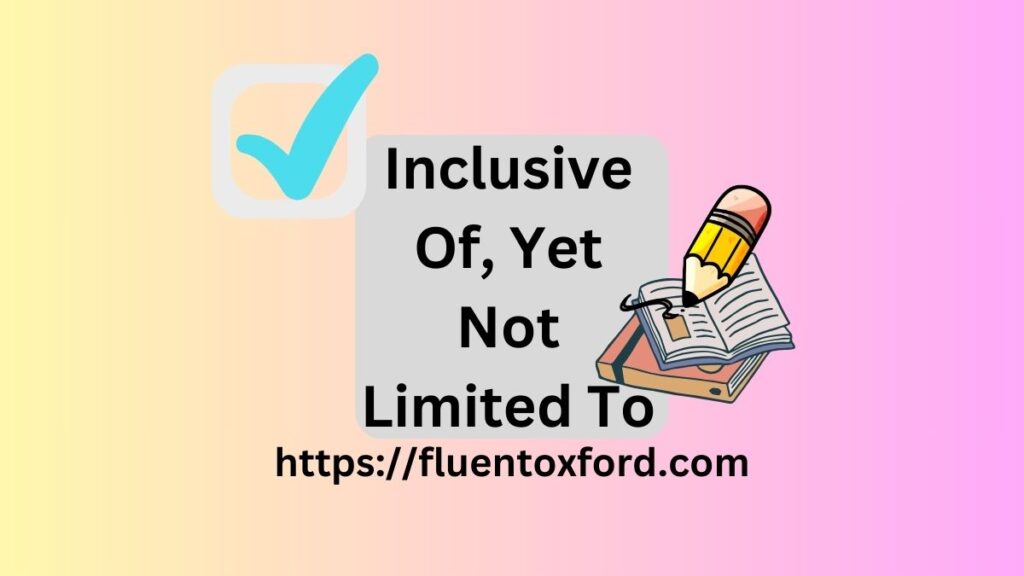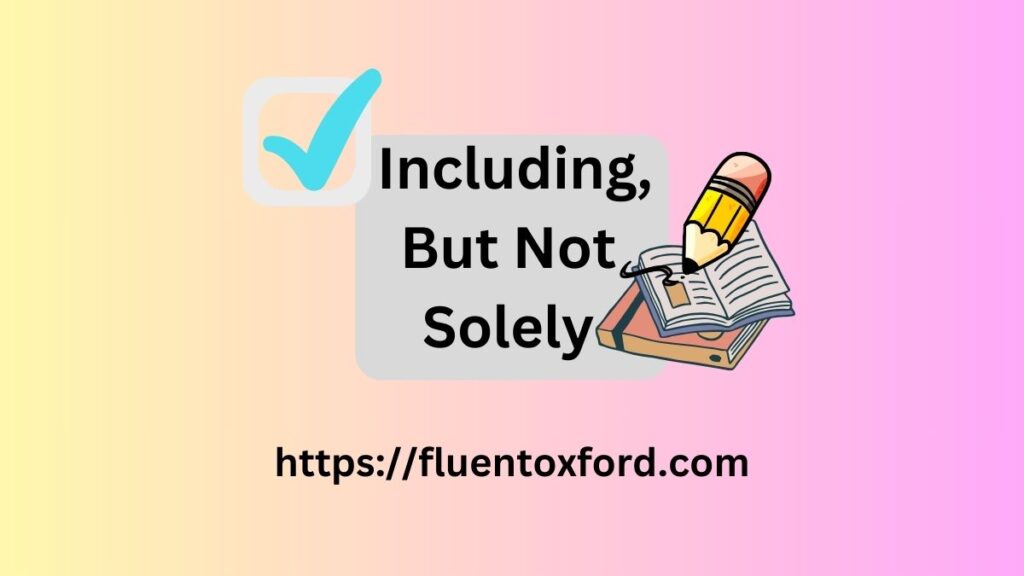When drafting legal documents, contracts, or professional communications, the phrase “including but not limited to” is commonly used to introduce examples while making it clear that the list is not exhaustive. This phrase ensures flexibility by indicating that additional items, beyond those explicitly mentioned, may also be relevant. However, its repeated use can make writing sound redundant or overly formal, prompting the need for alternative expressions. That’s where the 17 Other Ways to Say “Including But Not Limited To” come in—offering fresh, precise, and engaging ways to convey the same intent without sacrificing clarity.
Language should be dynamic, and using varied expressions enhances readability, professionalism, and engagement. If your writing feels monotonous or overly rigid due to excessive repetition of “including but not limited to,” you’re in the right place. This guide will introduce you to 17 Other Ways to Say “Including But Not Limited To”, helping you refine your communication while maintaining the same legal or formal precision.
Whether you’re crafting business proposals, legal contracts, or even creative content, diversifying your language is crucial. The 17 Other Ways to Say “Including But Not Limited To” will not only make your writing more compelling but also help you maintain a professional tone without sounding repetitive. From concise alternatives to more sophisticated expressions, these variations will give you the flexibility to adapt your writing to different contexts while keeping it polished and engaging.
A Non-Exhaustive List Includes
Best for: Legal and formal documents
This alternative retains the meaning of “including but not limited to” while using a slightly more structured form. It’s a solid choice for workplace etiquette in legal, business, and regulatory contexts.
Example:
“The job responsibilities of a project manager include a non-exhaustive list of planning, budgeting, and coordination.”
Why it works:
- Maintains the legal clarity of the original phrase.
- Sounds more professional in contracts and formal policies.
Some Options Are

Best for: Casual communication and everyday business writing
If you want a more approachable and conversational alternative, “some options are” works well. It’s excellent for lists that provide examples in effective communication.
Example:
“For this project, some options are using WordPress, Shopify, or custom-built platforms.”
Why it works:
- Sounds more natural in casual communication.
- Suitable for workplace etiquette when listing possibilities.
Such As, But Not Limited To
Best for: General writing and professional emails
This variation is nearly identical to the original phrase but flows more naturally in formal communication.
Example:
“We provide digital marketing services such as, but not limited to, SEO, PPC, and content marketing.”
Why it works:
- Keeps the original intent but sounds less legalistic.
- Useful in polite email closings and professional writing.
Including, Among Others
Best for: Professional and business contexts
This phrase is a great option when listing examples without sounding overly formal.
Example:
“Our core values emphasize transparency, innovation, and teamwork, including, among others, continuous learning and ethical decision-making.”
Why it works:
- More concise while still implying an open-ended list.
- Ideal for synonym selection in business communication.
Like, But Not Restricted To
Best for: Technical documents and industry-specific communication
When writing technical documents or instructional content, this phrase provides clarity while avoiding legal jargon.
Example:
“The software supports multiple formats like, but not restricted to, JPEG, PNG, and TIFF.”
Why it works:
- Works well in language usage for tech or instructional guides.
- Clarifies scope while staying professional.
Comprising, But Not Exclusively
Best for: Academic and research writing
For research papers, whitepapers, and academic reports, this phrase maintains specificity while broadening the list.
Example:
“The research focuses on behavioral patterns comprising, but not exclusively, social interactions and cognitive responses.”
Why it works:
- Fits well in word choice mastery for scholarly and professional documents.
- Clearly communicates that other factors exist beyond those listed.
Inclusive Of, Yet Not Limited To

Best for: Legal and policy documents
This phrase enhances the structure and readability of contractual statements and policies.
Example:
“The company’s employee benefits are inclusive of, yet not limited to, health insurance, paid time off, and retirement plans.”
Why it works:
- Enhances communication strategy in legal writing.
- Keeps the phrase formal while improving readability.
With Examples Such As
Best for: Explanatory content and presentations
For articles, reports, or presentations, this phrase helps maintain an engaging tone while listing examples.
Example:
“Modern business strategies involve digital transformation, with examples such as cloud computing and AI-driven analytics.”
Why it works:
- Keeps writing fluid in alternative expressions for content creation.
- Encourages better language usage in instructional writing.
Comprised Of, Among Other Things
Best for: Contracts and formal statements
This phrase is commonly used in formal communication where specificity and flexibility are needed.
Example:
“The agreement is comprised of, among other things, payment terms, confidentiality clauses, and dispute resolution procedures.”
Why it works:
- Helps in workplace etiquette for professional agreements.
- Gives room for additional, unstated components.
Containing, But Not Restricted To
Best for: Guidelines, policies, and disclaimers
This phrase is excellent for professional communication that requires structure and clarity.
Example:
“The report includes multiple datasets containing, but not restricted to, financial trends, customer behavior, and market predictions.”
Why it works:
- Works well in communication strategy for official documentation.
- Clearly sets scope while maintaining flexibility.
Involving, But Not Limited To
Best for: Reports, policies, and contracts
This phrase works well for emphasizing that multiple elements are involved, while still leaving room for other possibilities.
Example:
“The training program will cover topics involving, but not limited to, time management, leadership skills, and communication strategies.”
Why it works:
- It sounds formal but is flexible enough for different professional contexts.
- Clear and concise for explaining scope in a variety of documents.
Encompassing, But Not Exclusively
Best for: Formal documents, contracts, and policies
Ideal for emphasizing that the items mentioned are examples, but there’s always more.
Example:
“The job description includes responsibilities encompassing, but not exclusively, project management, team leadership, and client interaction.”
Why it works:
- Provides a professional tone without sounding too rigid.
- Works well in business communication to show flexibility in expectations.
Including, But Not Solely

Best for: Casual communication and reports
This variation softens the formal tone and works well in both casual communication and formal writing, maintaining readability.
Example:
“The report covers several key areas including, but not solely, financial performance, market trends, and customer satisfaction.”
Why it works:
- Flows smoothly in everyday business or personal writing.
- Softens the rigidity of overly formal alternatives while maintaining clarity.
In Addition To, But Not Exclusively
Best for: Business documents and academic writing
This phrase works well when you need to list a few examples but imply there are others not specifically mentioned.
Example:
“The proposal includes services in addition to, but not exclusively, consulting, training, and implementation.”
Why it works:
- It’s a natural and professional way to indicate more options exist.
- Suitable for polite email closings and when addressing stakeholders in business.
Not Exhaustively Including
Best for: Legal and regulatory documents
Used in legal communication or formal regulations, this phrase clearly signals that the list is not complete.
Example:
“The terms and conditions outlined are not exhaustively including payment methods, delivery times, and customer support policies.”
Why it works:
- Ideal for legal communication, as it keeps documents clear and precise.
- Emphasizes that other components might exist beyond the listed examples.
With a Range of Examples, Including
Best for: Instructional, educational content, and presentations
This alternative helps when providing a broad overview of examples in a more engaging and dynamic way.
Example:
“The course materials will focus on topics with a range of examples, including economics, marketing strategies, and case studies.”
Why it works:
- Perfect for educational communication, as it sounds inviting and flexible.
- Adds variety and shows that the list is not exhaustive.
As Well As, But Not Limited To
Best for: Business communication and professional writing
This alternative keeps your communication professional while ensuring it implies there’s more to be considered.
Example:
“The company’s core values include integrity, transparency, as well as, but not limited to, innovation, and customer focus.”
Why it works:
- Smoothly introduces multiple examples without sounding overly formal.
- Works well in workplace etiquette and professional discussions.
Key Takeaways:
- For legal and policy documents, use “A non-exhaustive list includes” or “Inclusive of, yet not limited to.”
- For casual or business communication, try “Some options are” or “With examples such as.”
- For technical or instructional writing, “Like, but not restricted to” works well.
- For academic and research contexts, opt for “Comprising, but not exclusively.”
By mastering language usage and word choice mastery, you can craft clearer, more engaging communication while maintaining workplace etiquette.
Table: Alternative Phrases for “Including But Not Limited To”
| Alternative Phrase | Best For | Example Usage |
| A Non-Exhaustive List Includes | Legal, Policy Docs | “The benefits include a non-exhaustive list of…” |
| Some Options Are | Business, Casual | “Some options are Google Docs, Notion, and Trello.” |
| Comprising, But Not Exclusively | Academic, Reports | “The findings comprise, but not exclusively, economic trends…” |
By selecting the right phrase for the right scenario, you ensure clarity, professionalism, and engagement in your writing!
Conclusion
In conclusion, knowing the “17 Other Ways to Say ‘Including But Not Limited To'” gives you more options to express yourself clearly and creatively. These alternatives help avoid repetition and make your writing more engaging. By using a variety of phrases, you can keep your audience interested and make your points more effective.
Using these alternative expressions allows you to communicate more precisely. Whether you are writing formally or casually, the “17 Other Ways to Say ‘Including But Not Limited To'” will enhance your vocabulary and help you sound more professional. It’s a simple yet powerful way to improve the way you convey ideas.
FAQs
1. Why should I avoid using “including but not limited to” in my writing?
Overusing this phrase can make your writing sound repetitive and overly formal. Using alternatives adds variety and enhances clarity.
2. When should I use “including but not limited to”?
Use it when you need to clarify that the list you’re providing is non-exhaustive, typically in legal, technical, or formal documents.
3. Can I use “including but not limited to” in casual writing?
It’s generally too formal for casual writing. For a more natural tone, try alternatives like “such as” or “some options are.”
4. Are there any better alternatives to “including but not limited to” for professional emails?
Yes! “Such as, but not limited to” or “including, among others” are great options for professional emails to sound clear and concise.
5. How do I choose the best alternative phrase?
Consider the tone and context of your writing. Use more formal alternatives like “comprising, but not exclusively” in legal documents, and simpler phrases like “such as” for casual communication.

As an admin at Fluent Oxford, Maida Queen is the driving force behind our vibrant learning community. With a deep passion for English language education, she ensures that our platform remains a dynamic, engaging, and supportive space for learners worldwide.
Maida expertly manages content, assists users with their grammar and fluency queries, and fosters an interactive environment where learning feels effortless and enjoyable. Whether you need guidance, motivation, or just a friendly face in the Fluent Oxford community, Maida is always there to help you reach your English language goals.








